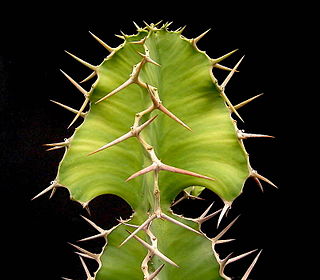
Royal Botanic Gardens, Kew, is a non-departmental public body in the United Kingdom sponsored by the Department for Environment, Food and Rural Affairs. An internationally important botanical research and education institution, it employs 1,100 staff. Its board of trustees is chaired by Dame Amelia Fawcett.

Botrychium is a genus of ferns, seedless vascular plants in the family Ophioglossaceae. Botrychium species are known as moonworts. They are small, with fleshy roots, and reproduce by spores shed into the air. One part of the leaf, the trophophore, is sterile and fernlike; the other, the sporophore, is fertile and carries the clusters of sporangia or spore cases. Some species only occasionally emerge above ground and gain most of their nourishment from an association with mycorrhizal fungi.

Joseph Marie Henry Alfred Perrier de la Bâthie was a French botanist who specialized in the plants of Madagascar.

Jean-François Séguier was a French archaeologist, epigraphist, astronomer and botanist from Nîmes.

Calycopeplus is a plant genus of the family Euphorbiaceae first described by Jules Émile Planchon as a genus in 1861. The entire genus is endemic to Australia. Its closest relative is Neoguillauminia from New Caledonia.

Halophila is a genus of seagrasses in the family Hydrocharitaceae, the tape-grasses. It was described as a genus in 1806. The number of its contained species, and its own placement in the order Alismatales, has evolved.

Cruciata laevipes is a species of flowering plant in the family Rubiaceae. It is commonly known as crosswort, smooth bedstraw or Luc na croise in Gaelic. The Latin epithet laevipes refers to the smooth stalk.

{{taxobox |image = Asteridea pulverulenta - Flickr - Kevin Thiele.jpg |image_caption = Asteridea pulverulenta |regnum = Plantae |unranked_divisio = Angiosperms |tribus=Gnaphalieae |unranked_classis = Eudicots |unranked_ordo = Asterids |ordo = Asterales |familia = Asteraceae |genus = Asteridea |genus_authority = Lindl. |type_species = Asteridea pulverulenta |type_species_authority = Lindl. }} Asteridea is a genus of flowering plants in the daisy family. Evidence suggests that the genus, Asteridea, is monophyletic.

Solidago gigantea is a North American plant species in the sunflower family. Its common names include tall goldenrod and giant goldenrod, among others.
Grevillea stenobotrya is a shrub in the family Proteaceae. It is endemic to arid regions of Australia. Common names include rattle-pod grevillea, sandhill grevillea and sandhill spider flower. Plants grow to between 1.5 and 6 metres in height and have leaves are linear and entire, or occasionally divided, and between 6 and 28 cm long and 0.7 to 2.5 mm wide. Flowers are cream, pale yellow or pale pink. These appear in clustered spikes at the end of branches between May and December in the species' native range. The fruits which follow are hard, flattened and rounded and have a short beak.

Symphyotrichum oolentangiense, commonly known as skyblue aster and azure aster, is a species of flowering plant in the family Asteraceae native to eastern North America.

Meeboldina is a plant genus in the family Restionaceae, described as a genus in 1943. It is named for the botanical collector Alfred Meebold.
Graziela Maciel Barroso (1912-2003) was a Brazilian botanist noted for being a leading expert on the flora of Brazil, as well as a specialist of Compositae. She was Chairman and Professor of the Department of Plant Biology at the University of Brasília, and published the three-volume Sistemática de Angiospermas do Brasil.

Scaevola collaris is a shrub in the family Goodeniaceae and its native range is five mainland states/territories of Australia: the Northern Territory, New South Wales, South Australia, Queensland and Western Australia.

Drosera finlaysoniana is a carnivorous herb found in Australia and south east Asia. More commonly found in the north of Australia. In southern Australian sites it has been recorded at inland areas, in eucalyptus woodlands subject to flooding. Also found in Hainan, Taiwan, the Indo-China region and the Philippines.

Cotula turbinata is a herb in the Asteraceae family native to the Cape Province, but found in India and in Australia
Periclesia is a monotypic genus of flowering plants belonging to the family Ericaceae. It only contains one known species, Periclesia flexuosaA.C.Sm. It is also with the Vaccinioideae subfamily and the Vaccinieae tribe.

Euphorbia grandialata is a species of flowering plant in the family Euphorbiaceae. It is endemic to South Africa in the Northern Cape. It was named by Robert Allen Dyer, in 1937.

Euphorbia breviarticulata is a species of flowering plant in the family Euphorbiaceae. Euphorbia breviarticulata was described by Ferdinand Albin Pax and published in Botanische Jahrbücher für Systematik, Pflanzengeschichte und Pflanzengeographie 34: 84. 1904.

Neogaya is a monotypic genus of flowering plants belonging to the family Apiaceae. It just contains one species, Neogaya simplex(L.) Meisn. It can be found in Europe, in the Alps, the western and southern Carpathians, also former Yugoslavia, Belarus and the European parts of Russia. It is also found in Asia, within Kazakhstan, China, and western Siberia.
















